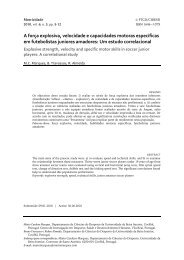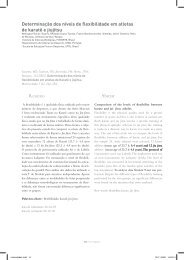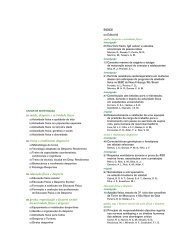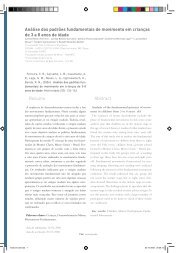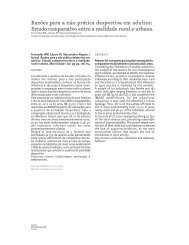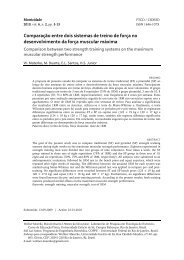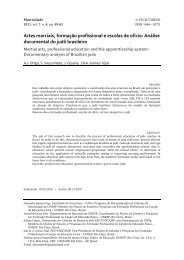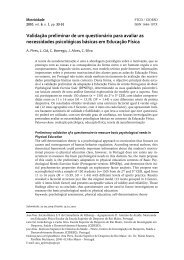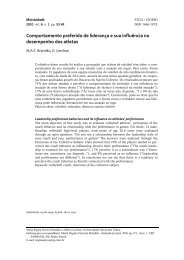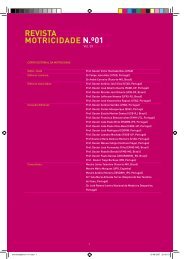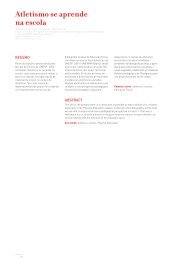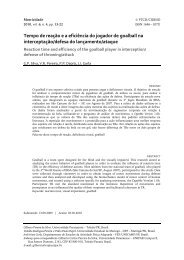revista motricidade
revista motricidade
revista motricidade
- No tags were found...
You also want an ePaper? Increase the reach of your titles
YUMPU automatically turns print PDFs into web optimized ePapers that Google loves.
64 | R.J. Ramos, V.R. Mantha, M.L. Novais, A.I. Rouboa, A.J. Silva, D.A. Marinho<br />
obter valores de arrasto de uma situação de<br />
deslize subaquático completo. Para além disso,<br />
tal como acima referido, a inclusão dos valores<br />
do arrasto de onda deve ser um aspecto<br />
decisivo a considerar.<br />
CONCLUSÕES<br />
O arrasto hidrodinâmico diminui à medida<br />
que a profundidade aumenta, verificando-se<br />
uma tendência para a estabilização deste valor<br />
a partir dos .75 m de profundidade. Estes<br />
dados parecem sugerir que a selecção da<br />
profundidade adequada para a realização do<br />
deslize subaquático deve ser uma preocupação<br />
central dos nadadores e treinadores. No<br />
entanto, a profundidade ideal terá de ser<br />
aquela que permita diminuir ao máximo o<br />
arrasto hidrodinâmico, mas, que ao mesmo<br />
tempo, permita uma distância vertical mínima<br />
da superfície para que o nado possa ser<br />
reiniciado, sendo esse equilíbrio entre<br />
diminuição do arrasto (aumentando a<br />
profundidade) e aumento da distância vertical<br />
percorrida um aspecto central a considerar.<br />
Agradecimentos:<br />
Este estudo foi financiado pela Fundação para a<br />
Ciência e a Tecnologia (PTDC/DES/098532/2008,<br />
FCOMP-010124-FEDER-009569; SFRH/BD/39511/<br />
2007).<br />
REFERÊNCIAS<br />
Barbosa, T. M., Keskinen, K., & Vilas-Boas, J. P.<br />
(2006). Factores biomecânicos e bioenergéticos<br />
limitativos do rendimento em natação pura<br />
desportiva. Motricidade, 2(4), 201-213.<br />
Bixler, B., Pease, D., & Fairhurst, F. (2007). The<br />
accuracy of computational fluid dynamics<br />
analysis of the passive drag of a male swimmer.<br />
Sports Biomechanics, 6(1), 81-98.<br />
Bixler, B. S., & Schloder, M. (1996). Computational<br />
fluid dynamics: An analytical tool for the 21st<br />
century swimming scientist. Journal of Swimming<br />
Research, 11, 4-22.<br />
Clarys, J. P., & Jiskoot, J. (1975). Total resistance of<br />
selected body positions in the front crawl. In J.<br />
P. Clarys & L. Lewillie (Eds.), Swimming II (pp.<br />
110-117). Baltimore: University Park Press.<br />
Cossor, J., & Mason, B. (2001). Swim start<br />
performances at the Sydney 2000 Olympic<br />
Games. In J. Blackwell & R. Sanders (Eds.),<br />
Proceedings of Swim Sessions of the XIX Symposium<br />
on Biomechanics in Sports (pp. 70-74). San<br />
Francisco: University of San Francisco.<br />
Guimarães, A., & Hay, J. (1985). A mechanical<br />
analysis of the grab starting technique in<br />
swimming. International Journal of Sport<br />
Biomechanics, 1(1), 25-35.<br />
Kolmogorov, S., & Duplishcheva, O. (1992). Active<br />
drag, useful mechanical power output and<br />
hydrodynamic force coefficient in different<br />
swimming strokes at maximal velocity. Journal<br />
of Biomechanics, 25(3), 311-318.<br />
Lyttle, A., Blansksby, B., Elliott, B., & Lloyd, D.<br />
(1999). Optimal depth for streamlined<br />
glidding. In K. L. Keskinen, P. V. Komi & A. P.<br />
Hollander (Eds.), Biomechanics and medicine in<br />
swimming VIII (pp. 165-170). Jyvaskyla:<br />
Gummerus Printing.<br />
Lyttle, A., Blanksby, B., Elliot, B., & Lloyd, D.<br />
(2000). Net forces during tethered simulation<br />
of underwater streamlined gliding and kicking<br />
technique of the freestyle turn. Journal of Sports<br />
Sciences, 18, 801-807.<br />
Marinho, D. A., Reis, V., Alves, F., Vilas-Boas, J.,<br />
Machado, L., & Silva, A. (2009). Hydrodynamic<br />
drag during gliding in swimming. Journal of<br />
Applied Biomechanics, 25(3), 253-257.<br />
Marinho, D. A., Barbosa, T. M., Reis, V. M.,<br />
Kjendlie, P. L., Alves, F. B., Vilas-Boas, J. P., …<br />
Rouboa, A. I. (2010). Swimming propulsion<br />
forces are enhanced by a small finger spread.<br />
Journal of Applied Biomechanics, 26, 87-92.<br />
Marinho, D. A., Reis, V. M., Vilas-Boas, J. P., Alves,<br />
F. B., Machado, L., Rouboa, A. I., & Silva, A. J.<br />
(2010). Design of a three-dimensional<br />
hand/forearm model to apply Computational<br />
Fluid Dynamics. Brazilian Archives of Biology and<br />
Technology, 5(2), 437-442.<br />
Polidori, G., Taiar, R., Fohanno, S., Mai, T., &<br />
Lodini, A. (2006). Skin-friction drag analysis<br />
from the forced convection modeling in<br />
simplified underwater swimming. Journal of<br />
Biomechanics, 39(13), 2535-2541.<br />
Ribeiro, J. (2010). Avaliação do efeito da profundidade<br />
no arrasto hidrodinâmico durante o deslize<br />
subaquático. Dissertação de Mestrado,<br />
Universidade do Porto, Portugal.<br />
Toussaint, H., Truijens, M., Elzinga, M.-J., De Ven,<br />
A., De Best, H., & Snabel, B (2002). Effect of a



